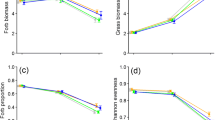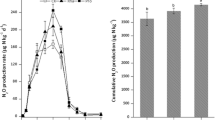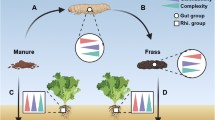Abstract
Previous theoretical and empirical evidence suggests that species composition within trophic levels may profoundly affect the response of trophic-level biomasses to enhanced basal resources. To test whether species composition of microbivorous nematodes has such an effect in microbial-based soil food webs, I created three microcosm food webs, consisting of bacteria, fungi, bacterial-feeding nematodes (Acrobeloides tricornus, Caenorhabditis elegans), fungal-feeding nematodes (Aphelenchus avenae, Aphelenchoides sp.) and a predatory nematode (Prionchulus punctatus). The food webs differed in species composition at the second trophic level: food web A included A. tricornus and Aph. avenae, food web B included C. elegans and Aphelenchoides sp., and food web AB included all four species. I increased basal resources by adding glucose to half of the replicates of each food web, and sampled microcosms destructively four times during a 22-week experiment to estimate the biomass of organisms at each trophic level. Microbivore species composition significantly affected bacterivore and fungivore biomass but not bacterial, fungal or predator biomass. Greatest bacterivore and fungivore biomass was found in food web A, intermediate biomass in food web AB, and smallest biomass in food web B. Basal resource addition increased the biomass of microbes and microbivores but did not affect predator biomass. Importantly, microbivore species composition did not significantly modify the effect of additional resources on trophic-level biomasses. The presence of a competitor reduced the biomass of A. tricornus and Aph. avenae, in that the biomass of these species was less in food web AB than in food web A, whereas the biomass of C. elegans and Aphelenchoides sp. was not affected by their potential competitors. The biomass of Aph. avenae increased with additional resources in the absence of the competitor only, while the biomass of A. tricornus and Aphelenchoides sp. increased also in the presence of their competitors. The results imply that microbivore species composition may determine the second-level biomass in simple microbe-nematode food webs, but may not significantly affect biomass at other levels or modify the response of trophic-level biomasses to enhanced basal resources. The study also shows that even if the role of predation in a food web is diminished, the positive response of organisms to increased resource availability may still be hindered by competition.
Similar content being viewed by others
Author information
Authors and Affiliations
Additional information
Received: 22 June 1998 / Accepted: 28 August 1998
Rights and permissions
About this article
Cite this article
Mikola, J. Effects of microbivore species composition and basal resource enrichment on trophic-level biomasses in an experimental microbial-based soil food web. Oecologia 117, 396–403 (1998). https://doi.org/10.1007/s004420050673
Issue Date:
DOI: https://doi.org/10.1007/s004420050673




